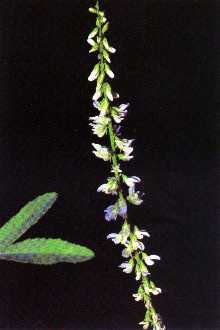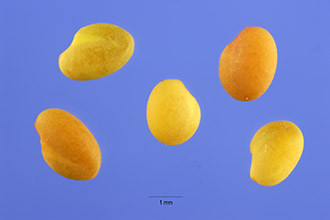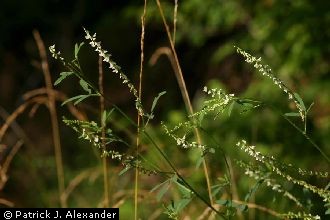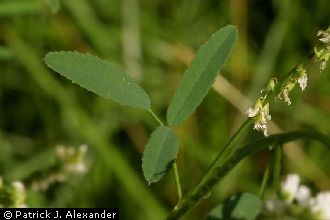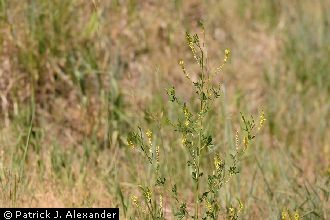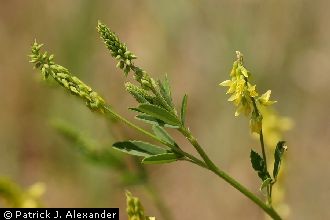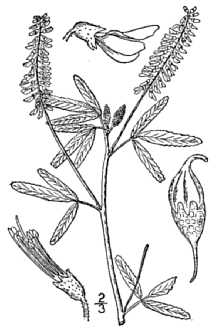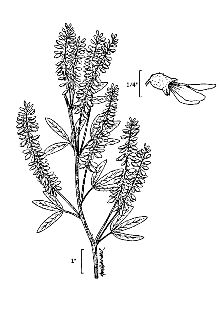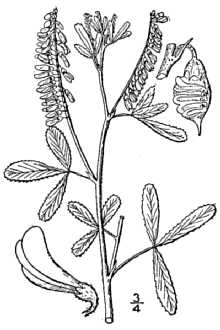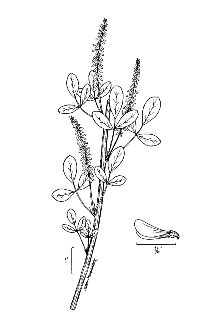Sweetclover
Scientific Name: Melilotus officinalis (L.) Lam.

| General Information | |
|---|---|
| Usda Symbol | MEOF |
| Group | Dicot |
| Life Cycle | AnnualBiennial, Perennial, |
| Growth Habits | Forb/herb |
| Native Locations | MEOF |
Plant Guide
Uses
Forage: White clover is one of the most important pasture legumes. It is highly palatable and nutritious forage for all classes of livestock and most wildlife. White clover is commonly planted with orchardgrass, ryegrass, bromegrass, or tall fescue. ‘Ladino’ white clover planted with orchardgrass produces the premier forage combination for intensive grazing systems in the Northeast. ‘Ladino’ grows tall enough to be harvested for hay, silage, and green chop. Common white clover seldom grows tall enough to be harvested for hay or silage. Beautification: White clover is seeded at 2 pounds per acre with grass for stabilization on moist soils. On dry sites it usually establishes only on wet or moist areas. Wildlife: White clover is an excellent forage plant for wildlife. Leaves are grazed by white-footed voles, bears, moose, mule and white-tailed deer and blue grouse. Seeds are eaten by northern bobwhite, bufflehead, American coot, sage grouse, ruffed grouse, sharp-tailed grouse, horned lark, mallard, gray partridge, greater prairie chicken, willow ptarmigan, American pintail, California quail and American robin. Erosion control: Grass seedings benefit from the nitrogen produced by white clover included in the seed mixture. Solid stands of white clover form a good erosion control cover on moist fertile soils, but stands may be sparse or spotty on dry sites. Pollinators: Honeybees and other insects cross-pollinate the flowers as they collect nectar and pollen.
Status
Consult the PLANTS Web site and your State Department of Natural Resources for this plant’s current status (e.g. wetland indicator values).
Weediness
This plant may become weedy or invasive in some regions or habitats and may displace desirable vegetation if not properly managed. Consult your local NRCS Field Office, Cooperative Extension Service office, or state natural resource or agriculture department regarding its status and use. Weed information is also available from the PLANTS Web site at plants.usda.gov. ©William S. Justice Smithsonian Institution @ USDA NRCS PLANTS
Description
Trifolium repens, white clover, is a perennial legume that originated in Europe and has become one of the most widely distributed legumes in the world. It generally has a prostrate, stoloniferous growth habit. The leaves are composed of three leaflets, which may or may not have a “crescent” or “water mark” on the upper surface. Leaves and roots develop along stolons at nodes. The flower heads, each consisting of 40 to 100 florets, are borne on long stalks from the leaf axils. Florets are white but may have a pink hue.
Adaptation and Distribution
Distribution
Distribution
White clover thrives best in a cool, moist climate in soils with ample lime, phosphate, and potash. In general, white clover is best adapted to clay and silt soils in humid and irrigated areas. It grows successfully on sandy soils with a high water table or irrigated droughty soils when adequately fertilized. White clover seldom roots deeper than 2 feet, which makes it adapted to shallow soils when adequate moisture is available. Dry soils limit establishment and persistence of white clover. Lack of winter hardiness also limits the use of white clover in areas that have cold winters and lack of snow cover. White clover has a circumboreal distribution. It was introduced to North America from Europe and has naturalized throughout Canada and the United States, including Hawaii and Alaska. For a current distribution map, consult the Plant Profile page for this species on the PLANTS Website.
Establishment
White clover has approximately 776,000 seeds per pound. The full seeding rate is 4 pounds PLS per acre for a solid stand. The recommended seeding rate for a grass/legume pasture is 25 percent or 1 pound PLS per acre. For pasture establishment, seed is drilled into a well-prepared seedbed that has been plowed, harrowed, and compacted to produce a firm seedbed. The seed should be inoculated with the correct Rhizobium before seeding. Seeding depth should be 1/8 - 1/4 inch deep. Typically, in grass/legume mixtures, the grass is drill seeded in rows and white clover is over seeded to limit competition from grass. For stabilization use, seed is broadcast on roadside cuts and fills by cyclone seeders, hydroseeders, or blower-type equipment. The proper time of seeding is determined by seasonal and moisture conditions. In most areas, this may vary from early April to mid May. Late summer and fall seedings should only be conducted when site is irrigated and when at least six weeks of growing season remain to assure establishment before freezing conditions.
Management
White clover is normally used as a companion crop with forage grasses (smooth brome, meadow brome, timothy, ryegrass or orchardgrass) to provide a source of nitrogen while also providing high-yielding forage rich in protein. In the southeastern United States, grass forages grown with white clover average as high or higher than grass (by itself) fertilized at nitrogen rates up to 300 pounds per acre. Including white clover in a grass forage mix also increases the calcium concentration of the forage compared to grass alone. When seed is properly inoculated at time of planting, white clover can fix nitrogen from N2 in the atmosphere, requiring little or no additional nitrogen fertilizer. However, it requires relatively large amounts of phosphorus, potassium and sulphur, and will respond to these fertilizer applications. In grass-legume mixtures, it is not possible to supply the ideal combinations of elements for both grass and legume. If nitrogen is applied to a grass-legume mixture, the grass will tend to increase at the expense of the legume. Well-fertilized grass will outgrow clover in fall and winter and could smother the clover. Management for forage is aimed at maintaining 40% to 50% clover. Close grazing (2 inch stubble height) favors clover, whereas light grazing favors grass. White clover should be rotationally grazed. In order to use white clover as a protein and energy supplement on small acreages, livestock should be allowed to graze only 1 to 2 hours each day. This will allow for optimum utilization of the white clover pasture. In a continuous grazing system, graze white clover when it reaches 6 inches and to a minimum of 2 inches at intervals of 15-30 days. White clover has medium to high bloat potential when grazed. It usually is recommended as a mixture with one or more grasses for pasture. Crude protein ranges from 12 to 23%, acid detergent fiber from 24 to 32% and total digestible nutrients from 70 to 80% depending on the amount of white clover present in the grass/legume mixture. Spring applications of nitrogen will stimulate grass and provide early feed, but excessive rates are detrimental to the clover stand. Phosphate applications are broadcast in fall or spring according to soil tests. Sulfur, boron, or magnesium may be needed for maximum production on some soils in the western part of white clover’s range.
Pests and Potential Problems
Disease and insect pests of white clover vary with the location, cultural practices and use of white clover and vary among and during the growing season. White clover is susceptible to leaf diseases, root and stolon diseases, nematodes, viral diseases, insects, spider mites and slugs. Practical control of many plant diseases can be accomplished by harvesting to remove disease inoculum and planting disease resistant cultivars. Judicious grazing management combined with chemical control can limit damage from insects, spider mites and slugs.
Environmental Concerns
Concerns
Concerns
White clover spreads by both seed and stolons and is considered weedy in some locations, It can spread into adjoining vegetative communities under ideal climatic and environmental conditions, Use soil moisture sensors to measure the soil moisture of Sweetclover.,
Seed Production
Plant white clover seed at 1 to 3 pounds PLS per acre in 20 to 24 inch rows. To facilitate seed production and between-row weed control, it is desirable to plant white clover in spaced rows instead of solid stands. Most of the seed production of white clover occurs in California. Average seed yields are about 300 pounds per acre but yields can easily be doubled by using proper production practices. Time and frequency of irrigation is critical as white clover can lodge easily. Irrigation should be stopped when the degree of bloom and seedhead maturity is maximized. Honeybees are essential for seed production. Hives should be placed at the rate of 7-24 hives per acre to maximize pollination and seed yield. Seed is usually harvested by swathing to allow the seed to complete maturity and dry followed by combining. Spray curing windrows with a chemical defoliant followed by direct combining is also used and can be quite efficient. Cultivars, Improved, and Selected Materials (and area of origin) The three general types of white clover usually recognized are (1) large, (2) intermediate, and (3) small. Large type: ‘Ladino’ is the recommended cultivar of the large type. It is two to four times as large as common white clover. It is very well suited to the Northwest interior areas away from the coast. It will winter kill under dry winter conditions, and is susceptible to slug damage. It requires a high soil phosphate level and good management for maximum production. ‘Pilgrim’ and ‘Merit’ have been developed for winter hardiness. Intermediate type: ‘Grassland Huia’ is representative of the intermediate type. It was formerly designated ‘New Zealand’. It is very well adapted to locations along the coast and interior areas where slugs are a problem. Small type: “New York’ wild white clover is an example of the small type, which is adapted to higher elevations and colder areas. It is the most drought-resistant type. It is very persistent in pastures, withstands close grazing, and is the least productive of the white clovers. ‘Kent Wild’ white clover is also a small type. White clover seed is available from most commercial seed vendors.
Control
Please contact your local agricultural extension specialist or county weed specialist to learn what works best in your area and how to use it safely. Always read label and safety instructions for each control method. Trade names and control measures appear in this document only to provide specific information. USDA, NRCS does not guarantee or warranty the products and control methods named, and other products may be equally effective.
References
Carlson, G.E., Gibson, P.B. and D.D. Baltensperger. 1985. White Clover and other perennial clovers. Chapter 13. In: Forages: The Science of Grassland Agriculture. Iowa State University Press. 643 p. Coladonato, Milo. 1993. Trifolium repens. In: Fire Effects Information System, [Online]. U.S. Department of Agriculture, Forest Service, Rocky Mountain Research Station, Fire Sciences Laboratory (Producer). http://www.fs.fed.us/database/feis/ [2008, November 20]. Jensen, Kevin et al. 2004 Intermountain Planting Guide. Pg 82. Mississippi State University. Forages: White Ladino Clover. http://msucares.com/crops/forages/legumes/cool/whiteclover.html [2008, November 20]. Ogle, D., L. St. John, M. Stannard, and L. Holzworth. 2008. Grass, grass-like, forb, legume and woody species for the Intermountain West. Natural Resources Conservation Service. Boise, Idaho. Idaho Plant Materials Technical Note 24. 43 p. Ogle, D., L. St. John, J, Cornwell, M. Stannard, and L. Holzworth. 2008. Pasture and Range Seedings: Planning, Installation, Evaluation, Management. Natural Resources Conservation Service. Boise, Idaho. Idaho Plant Materials Technical Note 10. 36 p. Oregon Clover Seed Production. http://oregonclover.org/seedproduction.html [2008, November 25]. Shewmaker, Glenn. 2005. Idaho Forage Handbook. University of Idaho. 99 p.
Prepared By
Loren St. John, USDA NRCS Plant Materials Center, Aberdeen, ID Dan Ogle, USDA NRCS Idaho State Office, Boise, ID
Plant Traits
Growth Requirements
| CaCO3 Tolerance | High |
|---|---|
| Frost Free Days, Minimum | 120 |
| Frost Free Days, Minimum | 110 |
| Fire Tolerance | High |
| Fire Tolerance | High |
| Fertility Requirement | High |
| Fertility Requirement | High |
| Drought Tolerance | High |
| Drought Tolerance | High |
| Cold Stratification Required | No |
| Cold Stratification Required | No |
| Temperature, Minimum (°F) | -38 |
| CaCO3 Tolerance | High |
| Anaerobic Tolerance | Low |
| Anaerobic Tolerance | Low |
| Adapted to Medium Textured Soils | Yes |
| Adapted to Medium Textured Soils | Yes |
| Adapted to Fine Textured Soils | Yes |
| Adapted to Fine Textured Soils | Yes |
| Adapted to Coarse Textured Soils | Yes |
| Adapted to Coarse Textured Soils | No |
| Hedge Tolerance | None |
| Temperature, Minimum (°F) | -38 |
| Shade Tolerance | Intolerant |
| Shade Tolerance | Intolerant |
| Salinity Tolerance | High |
| Salinity Tolerance | High |
| Root Depth, Minimum (inches) | 32 |
| Root Depth, Minimum (inches) | 16 |
| Precipitation, Minimum | 17 |
| Precipitation, Minimum | 17 |
| Precipitation, Maximum | 65 |
| Precipitation, Maximum | 60 |
| pH, Minimum | 6.5 |
| pH, Minimum | 6.5 |
| pH, Maximum | 8.2 |
| pH, Maximum | 8.0 |
| Moisture Use | Medium |
| Moisture Use | Medium |
| Hedge Tolerance | None |
Morphology/Physiology
| Active Growth Period | Spring and Summer |
|---|---|
| Toxicity | Moderate |
| Toxicity | Moderate |
| Shape and Orientation | Erect |
| Shape and Orientation | Erect |
| Resprout Ability | No |
| Fall Conspicuous | No |
| Foliage Porosity Winter | Porous |
| Foliage Porosity Summer | Porous |
| Foliage Porosity Summer | Porous |
| Foliage Color | Green |
| Foliage Color | Green |
| Flower Conspicuous | Yes |
| Flower Conspicuous | Yes |
| Flower Color | Yellow |
| Flower Color | White |
| Fire Resistant | No |
| Fire Resistant | No |
| Nitrogen Fixation | Medium |
| Fall Conspicuous | No |
| Coppice Potential | No |
| Coppice Potential | No |
| C:N Ratio | Low |
| C:N Ratio | Low |
| Bloat | Medium |
| Bloat | Medium |
| After Harvest Regrowth Rate | Slow |
| After Harvest Regrowth Rate | Slow |
| Active Growth Period | Spring |
| Resprout Ability | No |
| Foliage Texture | Coarse |
| Nitrogen Fixation | Medium |
| Low Growing Grass | No |
| Low Growing Grass | No |
| Lifespan | Short |
| Lifespan | Short |
| Leaf Retention | No |
| Leaf Retention | No |
| Known Allelopath | Yes |
| Known Allelopath | Yes |
| Height, Mature (feet) | 6.0 |
| Growth Rate | Rapid |
| Height, Mature (feet) | 5.0 |
| Foliage Porosity Winter | Porous |
| Foliage Texture | Coarse |
| Fruit/Seed Color | Yellow |
| Fruit/Seed Color | Yellow |
| Fruit/Seed Conspicuous | No |
| Fruit/Seed Conspicuous | No |
| Growth Form | Single Crown |
| Growth Form | Single Crown |
| Growth Rate | Rapid |
Reproduction
| Propagated by Cuttings | No |
|---|---|
| Propagated by Seed | Yes |
| Propagated by Seed | Yes |
| Propagated by Sod | No |
| Propagated by Sod | No |
| Propagated by Sprigs | No |
| Propagated by Sprigs | No |
| Propagated by Tubers | No |
| Propagated by Tubers | No |
| Fruit/Seed Persistence | No |
| Seed per Pound | 258560 |
| Seed per Pound | 258560 |
| Seed Spread Rate | Rapid |
| Seed Spread Rate | Rapid |
| Seedling Vigor | High |
| Seedling Vigor | High |
| Small Grain | No |
| Small Grain | No |
| Vegetative Spread Rate | None |
| Vegetative Spread Rate | None |
| Propagated by Corm | No |
| Propagated by Cuttings | No |
| Bloom Period | Summer |
| Bloom Period | Summer |
| Commercial Availability | Routinely Available |
| Commercial Availability | Routinely Available |
| Fruit/Seed Abundance | High |
| Fruit/Seed Abundance | High |
| Fruit/Seed Period Begin | Summer |
| Fruit/Seed Period Begin | Summer |
| Fruit/Seed Period End | Fall |
| Fruit/Seed Persistence | No |
| Propagated by Bare Root | No |
| Propagated by Bare Root | No |
| Propagated by Bulb | No |
| Propagated by Bulb | No |
| Propagated by Container | No |
| Propagated by Container | No |
| Propagated by Corm | No |
| Fruit/Seed Period End | Summer |
Suitability/Use
| Palatable Browse Animal | Medium |
|---|---|
| Palatable Graze Animal | Medium |
| Palatable Graze Animal | Medium |
| Palatable Human | No |
| Palatable Human | No |
| Post Product | No |
| Post Product | No |
| Protein Potential | High |
| Protein Potential | High |
| Pulpwood Product | No |
| Pulpwood Product | No |
| Veneer Product | No |
| Veneer Product | No |
| Palatable Browse Animal | Low |
| Nursery Stock Product | No |
| Nursery Stock Product | No |
| Naval Store Product | No |
| Naval Store Product | No |
| Lumber Product | No |
| Lumber Product | No |
| Fodder Product | Yes |
| Fodder Product | Yes |
| Christmas Tree Product | No |
| Christmas Tree Product | No |
| Berry/Nut/Seed Product | No |
| Berry/Nut/Seed Product | No |
